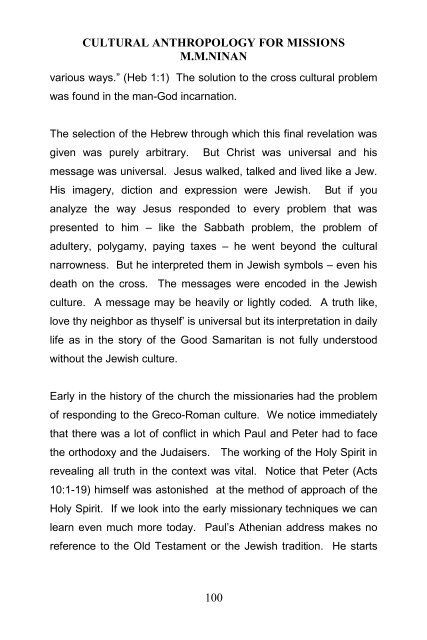Cultural Anthropology for Missions
Create successful ePaper yourself
Turn your PDF publications into a flip-book with our unique Google optimized e-Paper software.
CULTURAL ANTHROPOLOGY FOR MISSIONS<br />
M.M.NINAN<br />
various ways.” (Heb 1:1) The solution to the cross cultural problem<br />
was found in the man-God incarnation.<br />
The selection of the Hebrew through which this final revelation was<br />
given was purely arbitrary. But Christ was universal and his<br />
message was universal. Jesus walked, talked and lived like a Jew.<br />
His imagery, diction and expression were Jewish. But if you<br />
analyze the way Jesus responded to every problem that was<br />
presented to him – like the Sabbath problem, the problem of<br />
adultery, polygamy, paying taxes – he went beyond the cultural<br />
narrowness. But he interpreted them in Jewish symbols – even his<br />
death on the cross. The messages were encoded in the Jewish<br />
culture. A message may be heavily or lightly coded. A truth like,<br />
love thy neighbor as thyself’ is universal but its interpretation in daily<br />
life as in the story of the Good Samaritan is not fully understood<br />
without the Jewish culture.<br />
Early in the history of the church the missionaries had the problem<br />
of responding to the Greco-Roman culture. We notice immediately<br />
that there was a lot of conflict in which Paul and Peter had to face<br />
the orthodoxy and the Judaisers. The working of the Holy Spirit in<br />
revealing all truth in the context was vital. Notice that Peter (Acts<br />
10:1-19) himself was astonished at the method of approach of the<br />
Holy Spirit. If we look into the early missionary techniques we can<br />
learn even much more today. Paul’s Athenian address makes no<br />
reference to the Old Testament or the Jewish tradition. He starts<br />
100


















